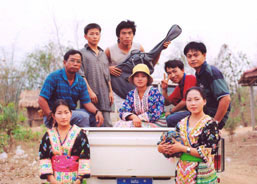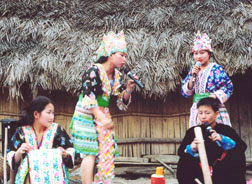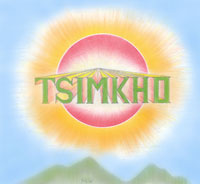| Background | |
| Hmong | |
| Khmu | |
| Yao | |
| Lahu | |
| Akha | |
| Stories | |
| Schedule | |
| Sponsorship | |
| Contact | |
| Team Tsim Kho - 'See the Light' Team | ||
| The Tsim Kho team live in Xaichaleun
village, in Nampuk area, in Houei Sai district (Bokeo province). Like
the other teams, their members are all farmers, some practising upland,
some lowland rice farming. They also raise pigs and chickens and some
plant corn and grow vegetables in small gardens. They belong to the
White Hmong subgroup. |
||
 |
 |
|
Since starting making theatre in March 2004, the team has created plays on to encourage adult women to participate in non formal education programmes, for the promotion of soyabean as a cash crop and 3 plays on the dangers of drug abuse (ATS).
Both the female and male team members love singing and have a large collection of over 100 songs, including traditional and modern Hmong, Laolum and Thai songs. Often Hmong villagers join in the performance with the songs they know and the result is a big concert after the play lasting until the small hours of the morning. For the Hmong, music and song is essential to the theatrical event. Two members of the team are talented artists and they are now learning
to produce visual aids for use in their presentations. |
||
| Hmong history and culture | ||
| The Hmong came from Southern China and
settled in Laos around 200 years ago. The Hmong have legends which
suggest their ancestors once lived in an icy land far to the north,
which indicates they may have originally moved to China (around 2000
years ago) from Mongolia, Siberia or Tibet. Around 315,000 live in
Laos in the present day. There are three types of Hmong in Laos: the Green, the White and the Black Hmong and each have their own distinctive dress. The clothes of the women have many colours and richly embroidered. The Hmong are animists and worship among others the sky spirit, who they believe created both the world and their own ancient way of life. There are many important everyday rituals related to placating the spirits that live in the house and other parts of the village. The Hmong live in on ground level houses made of rattan and wood, with thatched grass rooves. They are well known as talented silversmiths, which is reflected in the heavy earrings, necklaces and bracelets which the women wear on special occasions. The family is the most important unit in Hmong culture. People view themselves geographically as clan members and will often have stronger business ties to other Hmong villages in different provinces rather than to neighbouring villages of other ethnic minorities. The Hmong, even more than the other tribes, practice a strict male-female division of labor. One custom that especially illustrates this is that of giving a newborn boy a gift of metal from which he will one day forge a weapon. The Hmong have a written form of their own language, using roman letters. The men as the heads of the household and the ones responsible for business can speak, read and write Laolum. The women are often illiterate and some still cannot understand spoken Laolum. The Hmong New Year, celebrated in December after the rice harvest is the most important event in their calendar. Then there is a big party in every Hmong village and relatives often come from far off places to visit. This is a romantic time especially for young people who are looking to marry and hope to meet potential partners from other villagers. They dress in their best clothes and line up in couples and play a ball game called Njon Ma Kawn (throw a cloth ball) and flirt with one another through song all day. By the evening they have perhaps found the boy or girl they want to marry. |
||
